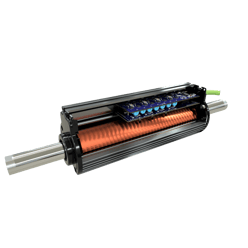- July 5, 2023
Smart Linear Motors: Explained
The electric motor transforms electrical energy into kinetic energy which has been one of the most impactful inventions for society over the last 200 years. They are used in an uncountable number of applications from mundane to intricate and generate billions of dollars in value every year. This class of human invention has been the subject of continued innovation since its inception, and today, partnered with modern semiconductors, sensor technologies, and a growing ability to optimize magnetics, the electric motor is the focus of some of the richest people and most brilliant engineers. Take the Tesla Model 3’s IPM-SynRM electric motor for example.
A subset of the electric motor, the linear electric motor, serves the world quietly on the factory floor, in the laboratory, at the physiotherapist, and in a handful of other places most folks don’t regularly think about. With that said, this “unrolled” version of the rotary electric motor is making our industries cleaner and more sophisticated by supplanting power-hungry and unreliable pneumatics with precision and efficiency.
|
Modern linear electric motors are evolving to serve a smarter world.
What is a Linear Motor and How is it Different From a Linear Actuator?
In the linear actuator game there are many players, with the goal being to convert energy into linear force and motion. Common methods employ compressed air, hydraulics, or electricity as the energy source, as seen below.
|
Linear Actuators |
|||||||
|
Pneumatic |
Hydraulic |
Electric |
|||||
|
Single/Double Acting |
Other |
Single Double Acting |
Other |
Screw-Driven |
Belt-Driven |
Linear Motor |
Other |
When compressed gasses are utilized, valves and pressure regulators serve as the means to control linear motion or forces. In hydraulic systems, valves and pumps are employed. In cases where electricity is used, an electric motor is utilized to convert electrical energy into linear force or motion, with a motor driver responsible for its control.
Among electric linear actuators, there are several methods of creating linear action, including gears, pulleys, and screws. Today we’re looking at Linear Motors - a subset of electric linear actuators - which produce force and motion using only magnetic interaction, and require no mechanical force transmission.
What is a Smart Linear Motor?

There are many traditional devices that today’s society has started calling “smart.” The smart watch, a smart home, smart TVs, smartphones…even smart toasters. When society starts labeling a technology as smart, it means that the tech knows something about its world. A smart watch can assess sleep quality, smartphones listen to conversation and can deliver targeted advertisements, and the smart toaster learns its user’s preferences for toasting bagels. These smart technologies have all had sensors and programmed logic built into them, and all of them know how to communicate. The concept is that this intelligence, borne from sensing, logic, and connectivity, enhances the life of the user and creates a smarter society.
And as toasters get smarter, so too do linear motors. Like smart devices, there are three primary things that set the smart linear motor apart from traditional linear motors: sensors, logic, and language.
Sensors
The first notable difference between typical linear actuators and smart linear motors is their sensors. A smart linear motor can measure its force generation, position, speed, acceleration, temperatures, and voltage. While this is normally done with external sensors, the smart linear motor packages and protects these senses within its body.
A few notable advantages that onboard sensors bring to a device:
- Low Latency Measurements - Since the smart linear motor samples these sensors locally, there are no communication delays and the amount of filtering required (and associated delays) are kept very low.
- High Durability - Due to the sensors being protected from the environment. Typically the sensors are epoxied into the motor body so vibrations, dust, and moisture have no effect. Also, the integrated force sensors on smart linear motors are immune to damage from overloading and have a wide dynamic sensing range.
- Consolidated Cabling - Because all the sensors reside on a PCB within the motor, no cables are needed to run back and forth to a PLC cabinet. This eliminates potential interference and EMI issues while reducing the system cost and install complexity.
In order to utilize sensor information gathered, on board logic is required.
Logic
Smart devices take the sensor information they collect, and combine it into something useful. In the case of a smart linear motor, the onboard logic can accomplish various tasks as the application requires:
- Force control is a functionality that can be used for haptic controls, stabilization systems, or process control like applying constant pressure to a grinder or polisher.
- Position control is performed with a proportional, integral, derivative (PID) or similar control loop which dynamically adjusts the force output of the motor to track a position target.
- Path planning can smoothly move the position target for the motor according to target speeds and accelerations and provide for highly controlled and repeatable motions.
- Haptic effects like springs, dampers, inertia, and vibrations can be processed locally.
Watch how these logic functions perform in the following videos:
- RELATED VIDEO 1: PLC Force Sensing Smart Linear Motor Demonstration
- RELATED VIDEO 2: Position and Force Control with ORCA Series Motors
- RELATED VIDEO 3: Force Sensing Smart Linear Motor vs. Egg Demonstration
Sensors and logic need to communicate within a system, using a shared language to function.
Language
Traditional motors do not communicate. These devices are simple coils of wire and magnets. All the sensing, logic, and communication is handled by external components including motor drivers, sensor amplifiers, and controllers.
Smart linear motors are different. Having these components integrated, they contain some kind of communication protocol which accepts commands for the motor’s behaviors, and reports information from its sensors.
Smart linear motor languages are typically some kind of serial communication, though it could also be a more primitive analog method, like the 4-20 mA current loop or digital voltage triggers. Whatever the communication method, there are often SDKs available that allow software developers to talk to the motor without having to fully understand all the details.
Understanding the role that sensors, logic and language broadly play in a feedback loop, we can more easily define what a smart linear motor is not.
What is not a Smart Linear Motor?
Every tool has a purpose but no tool solves all problems. While a lack of mechanical force transmission makes a linear motor fast, quiet, and smooth, it also poses challenges.
For instance, a linear motor moves freely when unpowered. For applications that require things to stay relatively rigid when powered off, this could be a problem. A related issue is that a linear motor requires a control loop to become ‘rigid’ or to very closely hold a position. While a screw drive can absorb disturbances in the mechanical transmission, and a hydraulic piston will absorb disturbances due to the incompressibility of the fluid, a linear motor typically must sense at least some position error before it can correct.
That said, smart linear motors have their own limits.
While smart linear motors have very high control loop frequencies and ultra low latency due to the locality of all the sensors and drivers, they can still not achieve as rigid a holding force as other technologies.
Another challenge of the linear motor is its need to draw power in order to hold a load against gravity or other sustained forces. The smart linear motor is no different in this regard. So when large sustained loads are present, other technologies or external compensation like springs are often needed.
What and Who are Smart Linear Motors for?
Unlike traditional linear motors, a smart linear motor can be used by designers and programmers who do not have traditional electrical engineering skills. They just require a good idea of what they need the device to do, and are comfortable communicating using its language or SDK. Compared to the excessive wiring, component mounting, and tuning required for a traditional linear actuator, the smart linear motor requires much less knowledge and training to become quickly proficient.
Essentially, the smart linear motor reduces the skill barrier requirement so that a mechanical engineer can get the results that were previously reserved for professionals with an electrical engineering background. However, just because it can be used by a wider range of professionals, doesn’t necessarily mean it’s the best choice for every linear motion application.
When Are They The Right Choice For An Application?
- When the linear motion application requires silence.
- When an application needs vibration control (elimination or generation).
- When repeatability, timing, and reliability are important.
- If the application needs data collection, high latency, or is otherwise preparing for initiatives related to industry 4.0.
- Reducing cost of ownership and operating costs by replacing pneumatics.
- Repetitive force sensitive applications that have relied on human movement (see force sensing egg demonstration example).
- Minimizing a plant’s reliance on costly and carbon intensive pressurized air power.
Are you interested to learn if a smart linear motor makes sense for your project application? Book a free consultation with our Applications Engineer and find out now!
